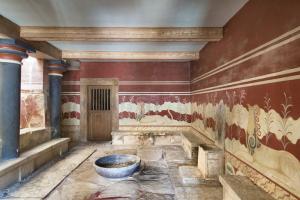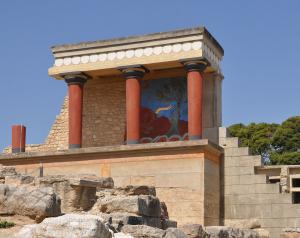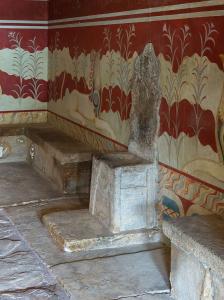 I cannot remember when I first read about the culture of the Minoans. I suppose I was in High School in some language class or other, reflecting on the origins of languages. (Yes, I was right and truly a nerd!) There was talk of a language called Linear B, scrolls of which were discovered on the island of Crete, a large body of land, south of mainland Greece, in the Mediterranean Sea. These documents were found at a very large temple/palace complex by Sir Arthur Evans on the island, a place he named the Palace of Minos, after the well-known story of the Minotaur, a terrifying beast caged in the basement of the palace that demanded sacrifice each year. As the myths are told, the hero Theseus is able to defeat the Minotaur with the help of Ariadne who supplied him with a ball of string enabling him to find his way out of the labyrinth of the palace’s many rooms after his defeat of the beast. The idea of a labyrinth in the myth perhaps arose from the fact of the enormous size of the palace, a complex that at its height covered over five acres of ground.
I cannot remember when I first read about the culture of the Minoans. I suppose I was in High School in some language class or other, reflecting on the origins of languages. (Yes, I was right and truly a nerd!) There was talk of a language called Linear B, scrolls of which were discovered on the island of Crete, a large body of land, south of mainland Greece, in the Mediterranean Sea. These documents were found at a very large temple/palace complex by Sir Arthur Evans on the island, a place he named the Palace of Minos, after the well-known story of the Minotaur, a terrifying beast caged in the basement of the palace that demanded sacrifice each year. As the myths are told, the hero Theseus is able to defeat the Minotaur with the help of Ariadne who supplied him with a ball of string enabling him to find his way out of the labyrinth of the palace’s many rooms after his defeat of the beast. The idea of a labyrinth in the myth perhaps arose from the fact of the enormous size of the palace, a complex that at its height covered over five acres of ground.
The palace possessed some astonishing features. Flush toilets were excavated in this complex nearly 4000 years old! The palace was perhaps completed in 1900BCE or so, and was rebuilt after a devastating earthquake some 200 years later. The Minoan civilization lasted for nearly 800 years, beginning in 2400BCE and essentially disappearing from history about 1600BCE. Certainly the most amazing feature of this culture was the fact that they had little if any conflict over nearly the whole of those 800 years! Think of any other culture that fought no wars of any size over that span of time, and the Minoans may have been unique indeed. Their glorious mosaics, some still intact after this vast time, record no battles at all. We see only glorious celebrations of the changing seasons, marked by acrobatic games like leaping over the backs of bulls. I was so taken with these stories and pictures that I hoped one day to go and see for myself.
 In 2005, I finally got my chance. I was asked to lecture on a cruise that included Crete and the port of Heraklion as part of the journey. So over 40 years after I first read about the Minoans, I saw the palace of Minos for the first time. I had read about the controversy stirred up by Evans’ excavations that began in 1900. He had a vivid imagination, far too vivid for many of his colleagues, and his reconstruction of a portion of the palace as he envisioned it has brought derisive attack from more than a few archaeologists. I am hardly equipped professionally to join in that abstruse discussion, but I admit that seeing Evans’ well-known work was helpful to my own imagination as I gazed on the palace, placed on a hill above the city and harbor.
In 2005, I finally got my chance. I was asked to lecture on a cruise that included Crete and the port of Heraklion as part of the journey. So over 40 years after I first read about the Minoans, I saw the palace of Minos for the first time. I had read about the controversy stirred up by Evans’ excavations that began in 1900. He had a vivid imagination, far too vivid for many of his colleagues, and his reconstruction of a portion of the palace as he envisioned it has brought derisive attack from more than a few archaeologists. I am hardly equipped professionally to join in that abstruse discussion, but I admit that seeing Evans’ well-known work was helpful to my own imagination as I gazed on the palace, placed on a hill above the city and harbor.
I wandered the ruins which were indeed extensive, seeing the famous toilets, looking at the “throne chair” of Minos (as Evans called it, though others disagree vehemently) and observing at least a portion of what became known as the labyrinth of rooms. But for me the most memorable time was my walking alone outside in the fields that surrounded the complex. As I ambled in the warm sunshine, my mind’s eye saw a woman, an ancient Minoan, carrying a water jar on her way from a spring back to the palace. She was striking in her ancient beauty, with a colorful shift-like robe covering her body and a veil guarding her hair. She walked in a stately splendor, languidly, easily, not fearful of anyone or anything as she performed her daily duty. She represented to me the peaceful ease with which the Minoans apparently lived while they planted their vineyards and grain and played in their strenuous and joyful games. I can hardly remember a more peaceful and lovely moment in my life, and I will always be grateful to that time on Crete among the ancient and generous Minoan people, long lost to most of us in the 21st century.
(as Evans called it, though others disagree vehemently) and observing at least a portion of what became known as the labyrinth of rooms. But for me the most memorable time was my walking alone outside in the fields that surrounded the complex. As I ambled in the warm sunshine, my mind’s eye saw a woman, an ancient Minoan, carrying a water jar on her way from a spring back to the palace. She was striking in her ancient beauty, with a colorful shift-like robe covering her body and a veil guarding her hair. She walked in a stately splendor, languidly, easily, not fearful of anyone or anything as she performed her daily duty. She represented to me the peaceful ease with which the Minoans apparently lived while they planted their vineyards and grain and played in their strenuous and joyful games. I can hardly remember a more peaceful and lovely moment in my life, and I will always be grateful to that time on Crete among the ancient and generous Minoan people, long lost to most of us in the 21st century.
How I envy them their ease and grace and peace! I have lived my life continually under the threat of that terrible mushroom cloud that still looms large in my consciousness even now in 2017. I participated in those laughable “duck and cover” exercises in my Phoenix grade school where our teachers suggested that diving under our school desks would give us a chance in the event of a nuclear explosion. Neither they nor we had a clue that if such a device ever did explode anywhere near us, we would be incinerated instantly, and if not, we would die a horrifying death due to radiation poisoning. The Minoans leapt over their bulls and worshipped their gods of grain and fruit oblivious of such massive threats, and as a result spent their time in invention and pleasure. Oh, I am sure they had any number of smaller fears; no human has lived completely free of fear. But as I look at those gorgeous mosaics, I am looking at a culture whose days were spent not in fear but in joy and lively thought.
I write this on the second day of 2018. What this New Year holds, I cannot begin to guess, but the challenges remain and the fears are real. We are not led by Minos but by Trump, a bigoted, narrow-minded, unthinking moron. I almost said “cretin,” but that word is too close to the place I celebrate this day, and I do not wish to sully it. Perhaps that vision of a Minoan woman, languidly carrying her jar through the Cretan fields, may help me keep hope alive in this time of fear and too much rage. And of course there is the vision of the Christ child, too, who swims into my mind when I am feeling like the world is collapsing around us. May that woman and that child be your beacon lights in this New Year as well.











